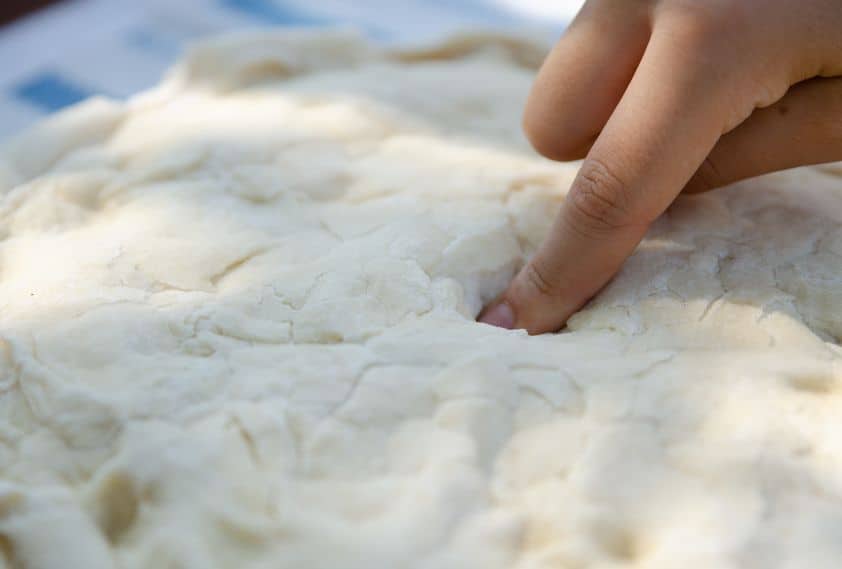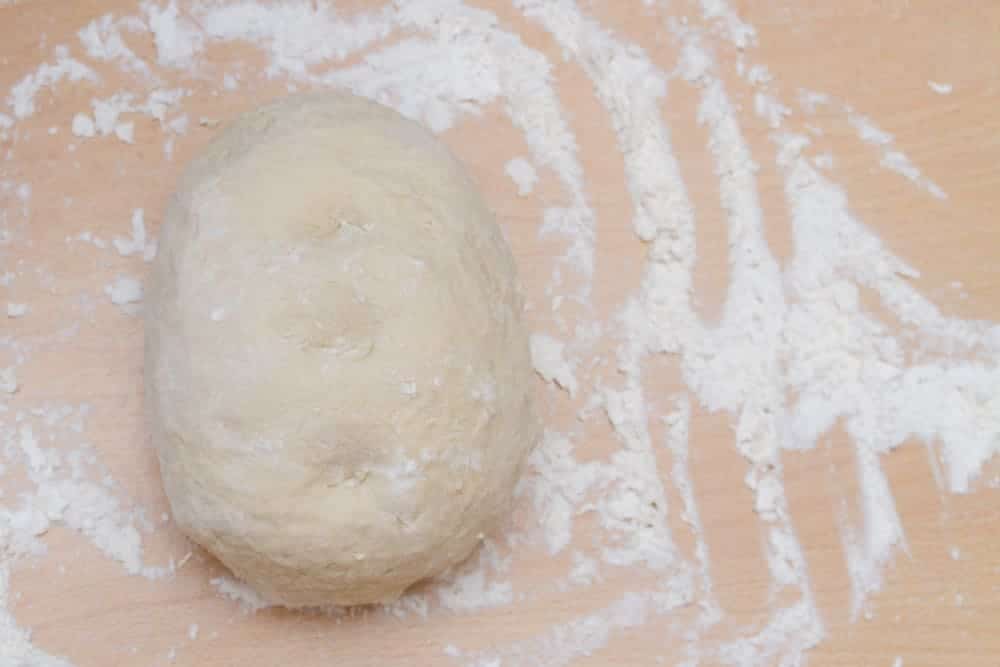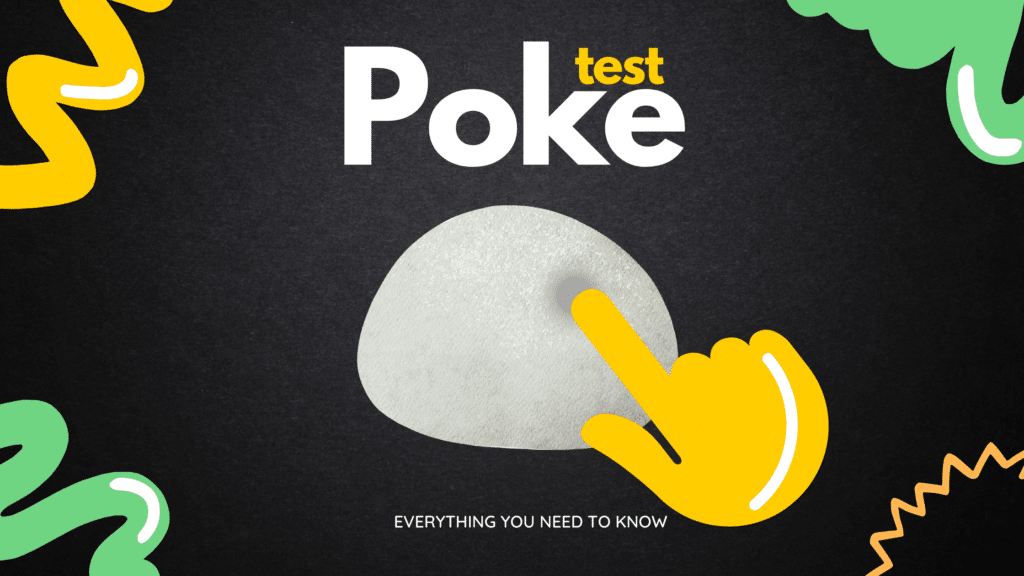Are you tired of ending up with a pizza crust that’s either too thick or still raw in some parts, no matter how much effort you put into making it?
Well, what if we told you there’s a simple and effective way to ensure your pizza crust is perfect every time you make it? Yes, we’re talking about the poke test!
In this post, we will dive deeper into the poke or “finger test” and how to use it to create the perfect pizza crust with well-developed gluten. Once you master this technique, you’ll be able to achieve that elusive crispy yet chewy texture in your pizza crust that you’ve been dreaming of.
So, let’s explore the poke test together and take your pizza-making skills to the next level!
Here’s What You Will Find:
Pizza Dough Poke Test
When it comes to making your pizza, one of the most important parts of the process is preparing your dough and making sure it’s ready to be turned into a pizza crust. Determining if your pizza dough has reached the critical state is actually pretty easy.
The poke test is a quick and easy method to ensure your pizza dough has finished rising or proofing and is ready to be rolled out and shaped into a pizza crust.
What is the Poke Test?
So, what exactly is the poke test?
The poke test is a simple technique used to determine whether the gluten in the shaped dough has been well-developed and ready to bake. The same test can be performed for bread dough or sourdough bread. To perform the test, you must take a small piece of dough from your bulk pizza dough and gently press it with your index finger or middle finger.

If the dough springs back slowly and leaves a small indentation, then the gluten has formed well, and the dough is ready to be shaped into a pizza crust.
On the other hand, if the dough springs back quickly or doesn’t leave an indentation at all, it means that the gluten has not yet formed properly, and the dough needs more time to rest and rise.
The significance of the results obtained from the poke test cannot be overstated. By checking the gluten development in the uncooked dough, you can ensure that your pizza crust will have the perfect texture and chewiness once it’s baked.
A well-developed gluten structure gives the crust it’s signature crispy exterior and a tender, slightly chewy interior. In contrast, underdeveloped gluten can result in a dense, tough, and unappetizing crust.
Therefore, performing the poke test is crucial in achieving the perfect pizza crust that will impress your taste buds and wow your guests.

How to Perform the Poke Test
Performing the poke test is a straightforward process, but it’s important to do it correctly to ensure accurate results. Here are the steps involved in performing the poke test:
- Take a small piece of dough from your pizza. You can use your hands or a bench scraper to do this.
- Roll the dough into a ball and flatten it slightly with your hands.
- With your finger, gently press the dough in the center. Use enough pressure to make a noticeable indentation but not so much that the dough tears or loses shape.
- Observe how the dough reacts. If the dough springs back slowly and leaves a small indentation, the gluten has formed well, and the dough is ready to be shaped into a pizza crust.
If the dough springs back quickly or doesn’t leave an indentation at all, it means that the gluten has not yet formed properly, and the dough needs more time to rest and rise.
If the dough needs more time, cover it with a damp cloth or plastic wrap and let it rest for 10-15 minutes. Then, repeat the poke test until the dough springs back slowly and leaves a small indentation.
That’s all there is to it! By performing the poke test, you can ensure your pizza crust turns out perfectly every time. It’s a quick and easy way to check the gluten development in your dough and make adjustments as needed.
Why is the Poke Test Important?
The poke test is an essential technique for achieving the perfect pizza crust. By checking the gluten development and bulk fermentation, you can ensure that your pizza crust will have the perfect texture and chewiness once it’s baked.
Gluten is a protein in wheat that makes dough stretchy and helps it rise. Yeast eats the sugars in the dough and produces carbon dioxide gas in the form of bubbles, which causes the dough to expand. Fermentation is when yeast consumes sugar, making the gluten network stronger and more elastic.
The poke test helps you check if the gluten in the dough has developed enough during fermentation. This is important to ensure that your pizza crust has the right texture and is delicious.
A well-developed gluten structure gives a properly proofed dough that bakes into a crust with a crispy exterior and a tender, slightly chewy interior. In contrast, underdeveloped gluten can result in a dense, tough, and unappetizing crust.
While some professionals can eyeball the amount of expansion or gauge the feel of the dough by touch alone, the poke test is a fool-proof method for amateurs and experienced pizza makers alike.
Tips on Performing the Poke Test
Here are some tips to help you achieve accurate results when performing the poke test:
Use room temperature dough: Make sure your pizza dough is at room temperature before performing the poke test. Cold dough will not give accurate results as it can be harder and less elastic than warm dough.
Don’t over-flour your dough: Over-flouring your dough can lead to dry and tough crusts. Instead, use a light dusting of flour when shaping your dough to prevent sticking.
Be gentle: When performing the poke test, be gentle to avoid tearing the dough or disrupting its shape. Use just enough pressure to make a noticeable indentation.
Use your finger: Using your finger rather than a tool to perform the poke test is best. Your finger is more sensitive and can give you a better feel for the dough’s elasticity and texture.
Repeat the test: If the dough springs back quickly or doesn’t leave an indentation at all, let it rest for a few minutes and perform the poke test again. It may just need more proofing time to rise and develop the gluten structure.
By following these tips, you can achieve accurate and consistent results when performing the poke test. Remember, the more you practice, the better you’ll become at gauging gluten development and achieving that perfect pizza crust.
Interpreting the Results of the Poke Test
Interpreting the results of the poke test can provide valuable information about gluten development and fermentation in your pizza dough, which can help you achieve the perfect crust. If the dough springs back slowly and leaves a small indentation, it indicates that the gluten has formed well and the dough is ready to be shaped into a pizza crust.
On the other hand, if the dough springs back quickly or doesn’t leave an indentation at all, it means that the gluten has not yet developed properly, and the dough needs more time to rest and rise during fermentation.
A quick spring back after poking tells you the dough is still producing gas and needs more time to rest. While if it only produces an indent without springing back, that means production has stopped completely, and your over-proofed dough will likely collapse in the oven.
Using the poke test results, you can adjust the entire proofing process time to ensure that the gluten development is sufficient, resulting in a crust with the perfect texture and flavor. This could involve letting the dough rest for a bit longer before shaping it or even refrigerating it to allow for a slower fermentation process. Adjusting the fermentation time based on the poke test results can be a game-changer in achieving the perfect pizza crust.
Why Do I Want to Oil or Flour My Finger Before I Perform the Poke Test?
You don’t want the dough to stick to your finger when you poke it. If the dough sticks to your hand, it will interfere with properly gauging its response to the poke test.
Other Tests
Is The Poke Test The Only Way to Determine the Readiness of My Pizza Dough?
No, the poke test is not the only way to determine the readiness of your pizza dough. While the poke test is a reliable and commonly used technique to check the gluten development in uncooked dough, there are other ways to test the readiness of your pizza dough as well.
Here are some other ways to test your pizza dough:
- The windowpane test: The windowpane test involves stretching a small piece of dough until it’s translucent and thin enough to see through, similar to a windowpane. If the dough can stretch without tearing and holds its shape, it can be shaped into a pizza crust.
- The rise test: Simply observe the dough as it rises. When the dough has doubled in size and feels light and airy to the touch, it’s ready to be shaped.
- The pinch test: Pinch a small piece of dough and stretch it between your fingers. It will be shaped if the dough stretches without tearing and feels soft and supple.
While the poke test is a great technique for determining the readiness of your pizza dough, trying out these other tests can help you develop a deeper understanding of the dough and its texture and may even help you refine your pizza-making skills even further.
The Last Slice
Mastering the poke test is essential for achieving the perfect pizza crust. By checking the gluten development in the uncooked dough, you can ensure that your pizza crust will have the perfect texture and chewiness once it’s baked.
A well-developed gluten structure gives the crust it’s signature crispy exterior and a tender, slightly chewy interior. In contrast, underdeveloped gluten can result in a dense, tough, and unappetizing crust.
Therefore, performing the poke test is crucial in achieving a delicious pizza crust that will impress your taste buds and wow your guests. By following the tips and techniques outlined in this post, you can become a pro at the poke test and take your pizza-making skills to the next level.
So, grab some dough, start poking, and get ready to create some mouth-watering pizzas that will have everyone begging for seconds!
Enjoy!
Not a PRO? Not a Problem!
Take a pizza class to bring your pizza skills to the next level,
so you can be a PRO!
Related Posts

Costco Pizza Delivery: Find How You Can Get It Now!
the PROs
People go to Costco’s food court for many different reasons, but the cheesy slice of pizza they serve is among …

Pizza for Beginners: Don’t Buy Pizza, Make It! Here’s How to Get Started!
the PROs
You have this idea that you want to make pizza at home as opposed to ordering it, but where do you start? Don’t worry! Here you will find answers and directions to all your questions.

Pizza Toppings Under Cheese or Over Cheese? [Why the Order Matters]
the PROs
Is Pizza Cheese on Top or Bottom? Hey pizza lovers, are you wondering if you should layer pizza toppings under …
Newsletter
Subscribe to our Recipe of the Week newsletter and receive our partners’ latest recipes, tips, and discount offers.
Keep in Touch!

